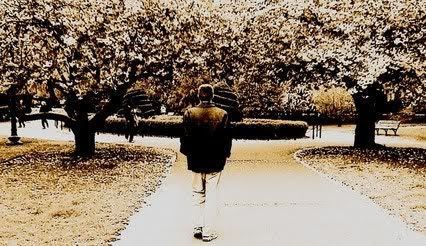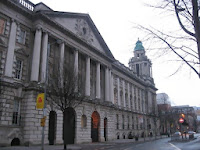Tonight I attended the Belfast City Council meeting, which was my first local politics meeting. Belfast politics are unique given the polarity of the parties and the power inherent in Northern Ireland's capital city.
Upon arrival I realized how very different such local politics operate here when I was asked what councillor was sponsoring my entrance. The city council is NOT open to the public, compared to the "town hall" model which is much beloved as an American institution. This was quickly remedied however by the kindness of Councillor Guy Spence who agreed to vouch for me. Spence is something of a wunderkind here in local politics, having been elected to the council at the tender age of 19, and surprisingly a member of the Democratic Unionist Party (though the true surprise probably would have been from him had I been forthcoming fully about the topic of my research project!). City councillors are allowed to sponsor two constituents to the gallery.
I gained admittance and was directed to the public gallery overlooking the south side of the chamber, where I got to speaking with a council employee who explained to me the layout of the chamber (nationalist/alliance parties on the north benches with unionist on the south). Public opinion is not solicited, with council meetings being a formality agreeing to what is passed in committee meetings. This makes sense considering the tight control with which British Politicians are bound to their party. When I asked if the public had the chance in committee meetings to then express their opinion, he seemed taken aback and remarked "that's what we elect representatives for!" He then elaborated that public constituency speak with their representatives directly if they wish to comment on a particular policy or matter of concern.
City Hall is an impressive architectural wonder from the turn of the 20th century that complements Belfast's former place as a shipbuilding/linen/ropemaking industrial center of the empire. Decorated in brightly painted plaster, murals, ornamentation, wrought iron, carved oak, marble, and stained glass, City Hall poses a picture of dissonance: what was built for the ascendancy of Lords and Ladies in robes and gowns, now occupied by a modern people representative of a power held firmly in the hands of the people. All under the prudish gaze of HRM Queen Victoria, peering out of her 15 foot high canvas. I can't but wonder what she would have thought?
Council opened with the entrance of the Lord Mayor, deputy Lord Mayor and High Sheriff who share the west dais. The Lord Mayor's chair is a huge affair, and I admit to having inwardly guffawed watching him struggle to drag it to the microphone, like some modern goldilocks. Then, once seated, Council opened with a reading from Proverbs 3:6 "In all thy ways acknowledge him and he will direct thy ways" (of which I'm still trying to figure out the applicability). Most of the items on the agenda were regarding city planning, council facilities (such as the Cherryhill sports complex), Tax levy rate freezes, and other items of council note which brought about lots of debate from the councillors representing the districts of Belfast.
Three items came to mind that struck me about the Belfast City Council. First, the sheer number of councilors, 51. Most cities I've lived in of a comparable size have had much smaller numbers (7-10). Second, most of the Councillors dressed fairly casually, in slacks with button up shirts open at the neck and either a sports coat or pullover. Northern Ireland is much less formal a society, and unlike city politics in the states, only the Lord Mayor and his deputies were in suits and ties. The final surprise was at the significant number of young faces who had been elected as City Councillors. This is very atypical of US politics, where city politicians are older and more experienced, and better able to run campaigns for competitive seats of which there are fewer, and require greater resources and business establishment courting to secure. Needless to say, it amazes me that despite the apathy of many young Northern Irish toward their political system and parties, it is also the young people who are getting involved and securing the future.
While expecting a rather dull and unexciting session, things got a bit heated when the issue of peace walls came up. Like a switch had been flipped, all of the councillor's eyes were riveted to the speakers who passionately spoke of their frustration of the other side "coming into their neighborhoods and accosting their pensioners homes and property." PUP Councillor Hutchinson remarked in particular that this wasn't 1998, nor 2008, rather the political scene was much more polarized (referring to the tumultuous events of the last year of parades rioting and flag protests), and therefore the peace walls were more integral today than they were then (to date there are more peace walls now than when the Good Friday Accords were signed in 1998, before the demilitarization of most of the paramilitaries). Yes, sectarian tensions still remain, and the political situation IS different than it was during the Good Friday peace talks occured; however, the differences and improvements within the society and functionality of a devolved executive and parliament must be acknowledged. Things ARE NOT ANYWHERE near as bad as they were in 1972 (bloody Sunday), 1974 (Sunningdale strikes), 1981 (hunger strikes), 1995 (canary Wharf), or 1998 (Omagh). Northern Ireland for the most part is a peaceful society with mild turbulence and crime rate lower than any other European or American city. Unemployment remains low, except among young folk in economically deprived areas whom experience difficulties in marketing their skills and finding steady employ. Granted, things are not perfect, but the problems that exist today are no more significant or encompassing than those facing any other country dealing with their past (hint hint, America, which still lurks under her shadow of slavery, Jim Crow segregation, and mass racial Criminal incarceration).
Northern Ireland has come far from (as SDLP Councillor Keenan put it) "the hard days," "the dark days," and her "baggage." A new era does indeed exist, that is no less difficult; with the legacy that instead of relying on fear and violence, these politicians now must learn to navigate their differences and geo-political aspirations within a democratic process. The armalite has been long retired, and the ballot box is the only legitimate tool. It takes time, it takes patience, and it takes a continued commitment to learning how to break down barriers and become a unified society. The great experiment of the 1990s is bearing fruit. Northern Ireland continues to be a success story.
.jpg)



I really enjoyed reading this. It was very informative, very discriptive and well written. I learned a lot from it. Thanks for the great read, Joshua. Keep 'em coming!
ReplyDelete